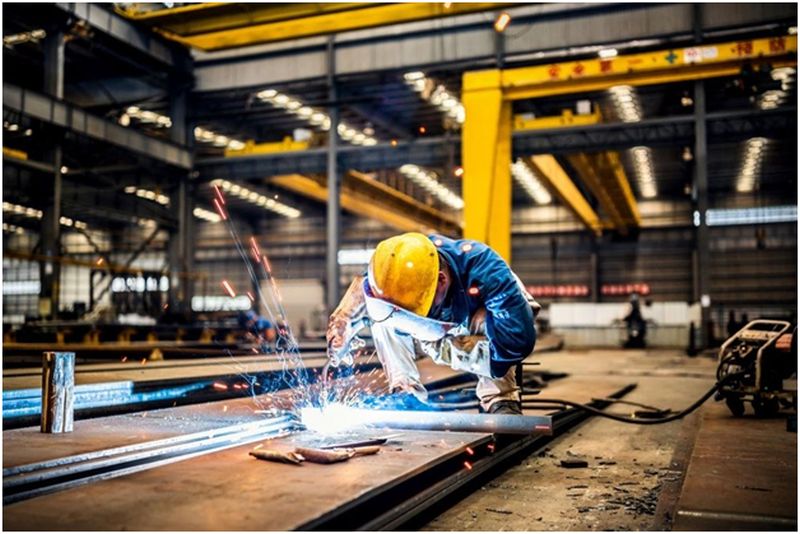Hot rolling and cold rolling are steel formation methods, and they affect the final weldability of steel.
But chemical composition and resulting mechanical properties impact steel weldability more than metalworking processes. Specifically, carbon content determines whether steel is easy or hard to weld.
Welding high-carbon steel (from 0.6% carbon) is a time-consuming process that requires many preparations and demands superior welding experience.
On the other side, low-carbon steel is easy to weld using virtually any welding method and technique. So why is high-carbon steel difficult to weld, and how does carbon content relate to hot-rolled and cold-rolled steel? Check this out below.
Why Is High-Carbon Steel Difficult to Weld?
Carbon defines ultimate steel hardness. The harder the metal, the more difficult it is to weld.
It’s because once heated to crazy temperatures typically persistent during welding, high-carbon steel forms a very brittle crystalline structure when it cools down. It results in numerous cracks across the heat-affected zone, making it hard to weld steel specimens.
Why Hot-Rolled and Cold-Rolled Steel Are Both Good for Welding
So super-hard high-carbon steel does not suit welding.
Structural steels, which hot-rolled and cold-rolled steels belong to, are a whole different story.
These materials are designed for producing and assembling steel parts to create metal products like shipping containers.
First, you need to fabricate steel sheets of the required dimensions. Then, you have to assemble them, which involves a lot of welding. The same goes for car parts, steel cabinets, and other items.
Hot-rolled and cold-rolled steels are mild, containing from 0.1% to 0.3% carbon. Such chemical composition makes them suitable for welding. The less carbon the material has, the easier it is to weld. It allows welders to use any methods and techniques when working with these steels.
3 Reasons Why Hot-Rolled Steel Is Easier to Weld

Still, hot-rolled metal might be a better pick for welding. Check the following advantages of hot rolled steel:
1. Surface Finish Doesn’t Matter
As you weld steel, its surface can change color and texture near the welding joint. But it’s not a big deal with hot-rolled steel because it comes for metal projects where the surface finish quality does not matter. If you produce shipping containers or building support structures, post-welding heat tints are the last thing to worry about.
2. Thick Metal is Easy to Weld
Hot-rolled metal ranges between 0.062”/1.6 mm to 0.39”/10 mm in thickness. TIG or MIG welding hot-rolled steel is easy, as you have a lower risk of burn-through with thick sheets. On the contrary, cold-rolled sheets are usually 0.030”/0.76 mm – 0.120”/3.05 mm thick.
That’s why welding cold-rolled steel requires more skills and time, as welders have far more chances to burn through a 0.030”/0.76-mm-thick sheet than a 0.39”/10-mm-thick one.
If you need hot rolled steel available in various thicknesses, you can check it at Metinvest. Select hot-rolled sheets by desired parameters on the site.
3. Welding Cold-Rolled Steel Weakens It
Steel hardens during cold-rolling. It is one of the benefits this process provides. Such metal typically doesn’t require heat treatment and comes 20% stronger than hot-rolled steel.
Welding renders this advantage useless because it melts and weakens metal at the heat-affected zone. After welding, a cold-rolled steel plate may require heat treatment.
A hot-rolled steel sheet doesn’t have such a flaw because no extra hardening techniques apply to it, and thus welding will not affect it as significantly as it affects cold-rolled steel.
The bottom Line
Both hot-rolled and cold-rolled steel variations suit welding because they contain little carbon. You can apply all welding methods to both steel types. But still, hot-rolled metal is simpler to weld due to greater thickness. Welding thicker sheets reduces the risks of melt-through.
Furthermore, you don’t have to deal with heat tints on the metal surface after welding because hot-rolled steel is used for applications where surface finish doesn’t matter.
Lastly, welding cold-rolled steel requires further heat treatment as it weakens the metal. It doesn’t happen with hot-rolled sheets. So if your metal project will involve a lot of welding, you should aim for hot-rolled steel.
Article Submitted By Community Writer


